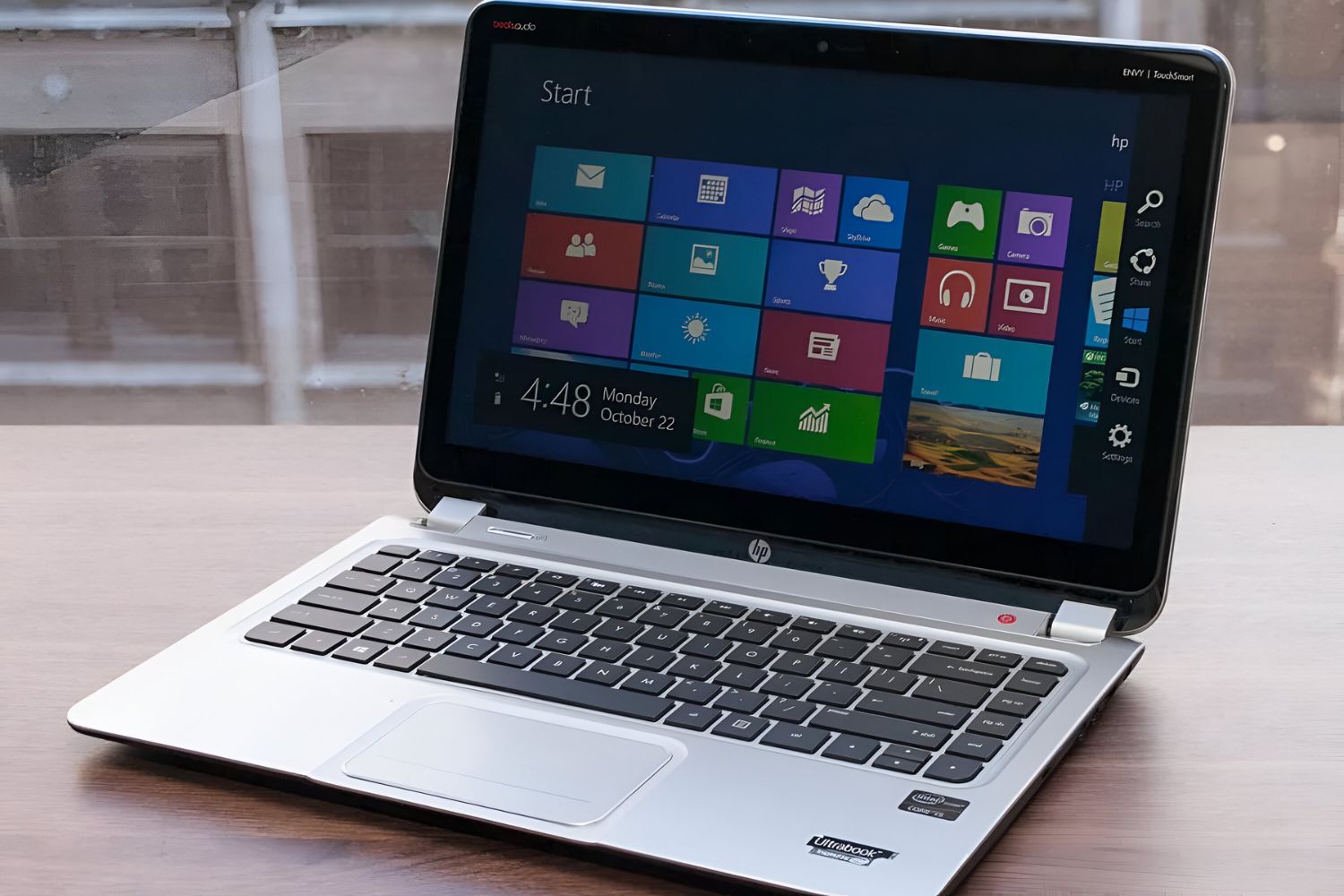Introduction
Welcome to this guide on how to recover your Envy Ultrabook 4 using Windows 10. Whether you’ve encountered a technical issue, software malfunction, or simply want to restore your device to its original state, this step-by-step tutorial will walk you through the recovery process.
If you’re experiencing crashes, errors, or a slow performance on your Envy Ultrabook 4, performing a recovery can be a helpful solution. Windows 10 offers various recovery options that allow you to troubleshoot and restore your system back to a working condition.
Before we start, it’s important to note that performing a recovery will erase all the data on your device, so it’s crucial to backup any important files or documents beforehand. Additionally, make sure your laptop is connected to a power source to prevent any disruptions during the recovery process.
In this guide, we will cover the steps required to recover your Envy Ultrabook 4 using the built-in recovery options provided by Windows 10. We’ll start with preparing for the recovery process and then proceed to access the Windows Recovery Environment. From there, we’ll explore various recovery options, including system restore, reset or refresh, and reinstalling Windows 10.
This guide assumes that you have a basic understanding of the Windows operating system and that you have access to a Windows 10 installation media or a recovery drive. Let’s dive in and get started on restoring your Envy Ultrabook 4 to its optimal performance!
Step 1: Prepare for Recovery
Before beginning the recovery process for your Envy Ultrabook 4, it’s essential to take a few preliminary steps to ensure a smooth transition. Here’s what you need to do:
1. Backup Your Data: As mentioned earlier, performing a recovery will erase all the data on your device. Therefore, it’s crucial to back up any important files, documents, or media to an external storage device or cloud storage service. This will ensure that you don’t lose any valuable data during the recovery process.
2. Check for Power: Make sure your Envy Ultrabook 4 is connected to a power source. Performing a recovery process takes time, and it’s important to have a stable power supply throughout the procedure. This will prevent any interruptions or issues that may occur due to a sudden power loss.
3. Disconnect External Devices: Remove any external devices, such as USB drives, SD cards, or external monitors, from your Envy Ultrabook 4. Keeping only the essential devices connected during the recovery process reduces the risk of any conflicts or issues that may arise from incompatible hardware.
4. Uninstall Non-Essential Software: Before initiating the recovery process, it’s recommended to uninstall any non-essential software or applications from your Envy Ultrabook 4. This will not only free up disk space but also ensure a cleaner and smoother recovery experience.
5. Gather Necessary Information: Before proceeding with the recovery, it’s a good idea to gather the necessary information required to reinstall or activate any licensed software programs. This includes product keys, license codes, or installation media for applications that you wish to reinstall on your Envy Ultrabook 4 after the recovery process.
By following these preparatory steps, you can ensure that your Envy Ultrabook 4 is ready for the recovery process. Taking the time to back up your data, ensuring a stable power supply, disconnecting external devices, uninstalling non-essential software, and gathering necessary information will contribute to a successful and hassle-free recovery experience.
Step 2: Accessing Windows Recovery Environment
In order to recover your Envy Ultrabook 4 using Windows 10, you’ll need to access the Windows Recovery Environment (WinRE). WinRE provides various troubleshooting options, including system restore, reset or refresh, and reinstalling Windows.
Here’s how you can access the Windows Recovery Environment:
1. Restart Your Envy Ultrabook 4: Start by shutting down your device completely. Then, press the power button to turn it back on. As soon as the HP logo appears on the screen, press the F11 key repeatedly until the “Choose an option” window appears. Alternatively, if your Ultrabook doesn’t have the F11 key option, you can also access WinRE by going to Settings > Update & Security > Recovery > Advanced Startup and clicking on the “Restart now” button.
2. Choose Troubleshoot: In the “Choose an option” window, click on the “Troubleshoot” option. This will open a new window with additional recovery options.
3. Select Advanced Options: In the Troubleshoot window, click on the “Advanced options” button. This will provide you with a range of advanced recovery options to choose from.
4. Choose the Desired Recovery Option: Depending on the issue you’re facing or the outcome you wish to achieve, you can choose from various recovery options available in the Advanced Options menu. These options may include System Restore, Reset This PC, or Command Prompt.
By following these steps, you can easily access the Windows Recovery Environment on your Envy Ultrabook 4. Once you’re in WinRE, you’ll have access to a range of recovery options that can help you troubleshoot and restore your device. In the next steps, we’ll explore these recovery options in detail, so you can choose the one that best suits your needs.
Step 3: Choosing Recovery Options
Once you have accessed the Windows Recovery Environment (WinRE) on your Envy Ultrabook 4, it’s time to choose the recovery option that best addresses your specific issue. Here, we’ll explore the different recovery options available to you:
System Restore: If you’re facing software issues or experiencing problems after installing certain programs or drivers, System Restore can be a helpful option. It allows you to revert your system back to a previous state when it was functioning properly. Select the System Restore option and follow the on-screen instructions to choose a restore point and initiate the restoration process. Note that this option will not affect your personal files but will uninstall any recently installed programs or drivers.
Reset This PC: If your Envy Ultrabook 4 is plagued with persistent issues or you simply want a fresh start, the Reset This PC option is worth considering. This option allows you to reinstall Windows while choosing whether to keep your personal files or remove everything. Select the Reset This PC option and follow the prompts to initiate the reset process. Note that resetting your PC will remove all installed programs and applications, so make sure to back up any important data beforehand.
Command Prompt: For advanced users or those facing specific technical issues, the Command Prompt option provides a powerful way to troubleshoot and resolve problems. By using command line tools and commands, you can perform various tasks, such as repairing the Master Boot Record (MBR), rebuilding the Boot Configuration Data (BCD), or running system scans for errors. Select the Command Prompt option to access the command line interface and enter the necessary commands as instructed.
By carefully considering your specific issue and the desired outcome, you can choose the recovery option that will best address your needs. Whether it’s restoring your system to a previous state, performing a full reset, or using the command line tools for advanced troubleshooting, these recovery options provide you with the flexibility to regain control and fix any issues on your Envy Ultrabook 4.
Step 4: Selecting the Troubleshooting Option
After accessing the Windows Recovery Environment (WinRE) and choosing to troubleshoot your Envy Ultrabook 4, it’s time to select the specific troubleshooting option that aligns with your recovery goals. Here are some of the key options to consider:
Startup Repair: If your Envy Ultrabook 4 is encountering startup issues, such as the infamous “blue screen of death” or constant system crashes, the Startup Repair option can help diagnose and fix the problem. It will analyze your system’s startup configuration and attempt to repair any issues that may be preventing your device from booting properly.
System Image Recovery: If you have previously created a system image backup of your Envy Ultrabook 4, the System Image Recovery option allows you to restore your device to that specific state. This option is useful when you want to revert your system back to a known working configuration, especially after a major software or hardware issue.
Go back to the previous version of Windows: If you recently upgraded your Envy Ultrabook 4 to a newer version of Windows 10 and are experiencing compatibility issues, driver conflicts, or other critical problems, this option allows you to roll back to the previous version. It will uninstall the current version and restore your device to the earlier state, along with all the files and settings.
UEFI Firmware Settings: If you need to access and modify the UEFI (Unified Extensible Firmware Interface) settings on your Envy Ultrabook 4, this option allows you to do so. UEFI settings are responsible for controlling various hardware settings and configurations, and accessing them can be helpful for troubleshooting certain issues or making specific changes.
Depending on the symptoms or issues you’re experiencing, choose the troubleshooting option that can best address the problem at hand. Remember to carefully read the descriptions and instructions provided for each option, as they may vary slightly across different device models and Windows versions. The objective is to diagnose and resolve any underlying issues that are impacting the performance and functionality of your Envy Ultrabook 4.
Step 5: Initiating a System Restore
If you’re encountering software issues or facing problems on your Envy Ultrabook 4 after installing certain programs or drivers, initiating a system restore can be an effective solution. System Restore allows you to roll back your computer’s settings to a previous point in time when it was functioning without any issues.
To initiate a system restore on your Envy Ultrabook 4, follow these steps:
1. Access the Windows Recovery Environment (WinRE): Restart your laptop and press the F11 key repeatedly as soon as the HP logo appears on the screen. This will launch the WinRE environment, providing you with various recovery options.
2. Choose System Restore: In the WinRE window, select the “Troubleshoot” option, followed by “Advanced options.” From the list of advanced options, choose “System Restore.”
3. Select a Restore Point: The System Restore wizard will now open, presenting you with a list of available restore points. These restore points are automatically created by Windows at various intervals or can be manually created by you. Select a restore point that precedes the appearance of the issues you’re experiencing on your Envy Ultrabook 4.
4. Begin the Restoration Process: Once you’ve selected a restore point, click on “Next” to proceed. Review the details of the restore point and ensure that it aligns with your desired restoration. Click on “Finish” to initiate the system restore process.
5. Wait for the Restoration to Complete: The system restore process will now begin, reverting your Envy Ultrabook 4’s settings and configuration back to the selected restore point. This may take some time, so be patient and avoid interrupting the process.
6. Restart Your Laptop: Once the restoration process is complete, your Envy Ultrabook 4 will automatically restart. You should now be able to use your laptop with the settings and configurations from the restored point in time.
By following these steps, you can initiate a system restore on your Envy Ultrabook 4 and potentially resolve software issues or conflicts. Remember that performing a system restore will not affect your personal files, but it will uninstall any programs or system updates that were installed after the selected restore point. Keep this in mind when choosing a restore point to ensure that the issues you’re facing can be resolved effectively.
Step 6: Performing a Reset or Refresh
If you’re experiencing persistent issues on your Envy Ultrabook 4 or simply want to start fresh, performing a reset or refresh can help restore your device to its original state. Windows 10 provides two options – Reset This PC and Refresh Your PC – each serving a different purpose. Here’s how to perform a reset or refresh:
Reset This PC: The Reset This PC option allows you to reinstall Windows while choosing whether to keep your personal files or remove everything. This is useful when you want to start with a clean slate or if your Envy Ultrabook 4 is facing significant performance issues. To perform a reset:
- Access the Windows Recovery Environment (WinRE) using the F11 key or other available methods.
- Select “Troubleshoot” and then “Reset This PC.”
- Choose between “Keep my files” or “Remove everything” based on your preference.
- Follow the on-screen instructions to initiate the reset process.
- Wait for the reset process to complete, and your Envy Ultrabook 4 will restart with a fresh installation of Windows.
Refresh Your PC: The Refresh Your PC option is ideal when you want to maintain your personal files but restore Windows settings and applications to their default state. This option helps resolve certain software issues without affecting your data. Here’s how to perform a refresh:
- Access the Windows Recovery Environment (WinRE) using the F11 key or other available methods.
- Select “Troubleshoot” and then “Reset This PC.”
- Choose the “Keep my files” option.
- Follow the on-screen instructions to initiate the refresh process.
- Wait for the refresh process to complete, and your Envy Ultrabook 4 will restart with a fresh installation of Windows while preserving your personal files.
Performing a reset or refresh can help resolve many persistent issues on your Envy Ultrabook 4 without the need for costly repairs or extensive troubleshooting. However, keep in mind that both options will remove any installed programs and applications. Make sure to back up your important data before proceeding.
Step 7: Reinstalling Windows 10
If you’ve exhausted all other recovery options and are still facing persistent issues on your Envy Ultrabook 4, reinstalling Windows 10 can provide a fresh start and resolve underlying software problems. Here’s how to reinstall Windows 10:
- Access the Windows Recovery Environment (WinRE) using the F11 key or other available methods.
- Select “Troubleshoot” and then “Reset This PC.”
- Choose the “Remove everything” option to erase all data on your Ultrabook 4.
- Select “Only the drive where Windows is installed” to reinstall Windows 10 on the current system drive.
- Follow the on-screen instructions to initiate the reinstallation process.
- Windows 10 will be reinstalled on your Ultrabook 4, and you may need to wait for the process to complete.
- Once the reinstallation is finished, proceed with the initial setup by following the prompts on the screen.
- After the setup is complete, make sure to install all the necessary drivers and update Windows to the latest version for optimal performance and security.
Reinstalling Windows 10 can be a time-consuming process, but it’s often the most effective solution to resolve complex software issues or persistent problems on your Envy Ultrabook 4. Remember to back up any critical data before initiating the reinstallation, as all files and applications will be removed during the process.
Additionally, ensure that you have access to the necessary drivers for your Ultrabook 4, especially for components such as graphics, audio, and network adapters. These drivers can be downloaded from the HP support website or other reliable sources to ensure proper functionality after the reinstallation.
By reinstalling Windows 10, you can give your Envy Ultrabook 4 a fresh start with a clean installation and potentially resolve the issues that were affecting its performance and usability.
Step 8: Reinstalling Drivers and Software
After reinstalling Windows 10 on your Envy Ultrabook 4, it’s crucial to reinstall the necessary drivers and software to ensure optimal performance and functionality. Here’s how to reinstall drivers and software:
- Identify the Drivers: Determine which drivers are required for your Envy Ultrabook 4’s hardware components. Common drivers include graphics, audio, network, touchpad, and chipset drivers. Visit the HP support website or the manufacturer’s website to download the latest versions of these drivers.
- Install Drivers: Begin with the most critical drivers, such as chipset and network drivers, to establish a stable foundation. Run the driver installation files and follow the on-screen instructions. Restart your Ultrabook 4 if prompted.
- Windows Update: After installing essential drivers, connect your Envy Ultrabook 4 to the internet and run Windows Update. This will detect and install any remaining driver updates.
- Install Software: Once all necessary drivers are installed, proceed to reinstalling any software applications that were previously installed on your Ultrabook 4. This includes productivity tools, media players, antivirus software, and any other programs you rely on.
- Download from Trusted Sources: Download the software applications from reputable sources, such as the official websites of the software providers or reliable download platforms. Be cautious of downloading from unknown or untrusted sources to avoid installing malware or unwanted programs.
- Activate and Update: During the installation of software applications, make sure to activate the software using valid licenses or product keys. Additionally, check for any updates or patches available for the installed programs to ensure they are up-to-date.
Reinstalling drivers and software is essential to restore the full functionality of your Envy Ultrabook 4 after a Windows reinstallation. By installing the latest drivers and updated software, you can benefit from improved compatibility, performance, and security.
Remember to restart your Ultrabook 4 as necessary during the driver installation process and to regularly check for driver and software updates to keep your system running smoothly.
Step 9: Restoring Personal Files and Settings
After reinstalling Windows 10 and reinstalling the necessary drivers and software, it’s time to restore your personal files and settings on your Envy Ultrabook 4. Here’s how you can accomplish this:
- Locate Your Backup: If you previously created a backup of your personal files and settings, connect the external storage device or access the cloud storage service where the backup is stored.
- Copy Files: Copy your personal files, such as documents, photos, videos, and music, from the backup location to your Envy Ultrabook 4. You can do this by using File Explorer and navigating to the appropriate folders on your system drive.
- Import Email and Browser Data: If you use email clients like Microsoft Outlook, import your email settings and messages from your backup. Similarly, if you use web browsers like Google Chrome or Mozilla Firefox, sign into your account and sync your bookmarks, history, and other preferences.
- Restore Custom Settings: If you had customized certain settings or preferences on your Envy Ultrabook 4, take the time to restore them. This can include desktop wallpaper, screensaver preferences, notification settings, and other personalization options.
- Reinstall and Configure Applications: Reinstall any additional software applications that were not included in the previous software installation process. Configure them according to your preferences and input any appropriate license keys or activation information.
- Test and Verify: Once all your personal files are restored and applications are configured, it’s important to test your Ultrabook 4 to ensure everything is functioning correctly. Open your files, launch applications, and perform common tasks to confirm that your restored personal files and settings are working as expected.
By following these steps, you can restore your personal files, preferences, and custom settings on your Envy Ultrabook 4. This will help you regain a familiar computing environment and ensure that your important data is accessible and organized.
Remember to keep your personal files regularly backed up to prevent data loss in the future. Utilizing cloud storage services or external storage devices can provide an extra layer of protection for your files and make the recovery process easier in the event of any future issues.
Conclusion
Congratulations! You have successfully learned how to recover your Envy Ultrabook 4 using Windows 10. This comprehensive guide has walked you through the step-by-step process of preparing for recovery, accessing the Windows Recovery Environment, choosing recovery options, initiating a system restore, performing a reset or refresh, reinstalling Windows 10, reinstalling drivers and software, and restoring your personal files and settings.
By following these steps, you can effectively troubleshoot and resolve software issues, restore your device to its original state, and ensure optimal performance on your Envy Ultrabook 4. It’s important to remember that performing a recovery or reinstalling Windows will erase your data, so be sure to backup any important files before beginning the process.
Throughout the recovery process, make sure to stay patient and carefully follow the instructions provided. Take note of any specific instructions or prompts that may vary based on your device model or version of Windows 10.
Remember to regularly update your drivers and software, keep your Envy Ultrabook 4 protected with reliable antivirus software, and maintain a backup routine for your personal files. These practices will help prevent future issues and ensure a smooth computing experience.
If you encounter any difficulties during the recovery process or face unique challenges, it’s best to consult the official documentation provided by HP or seek support from their customer service team for further assistance.
We hope this guide has been helpful in recovering your Envy Ultrabook 4 and getting it back to optimal performance. Enjoy your refreshed device and the seamless computing experience it now offers!

























